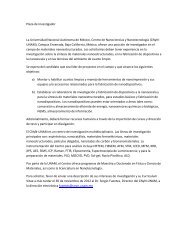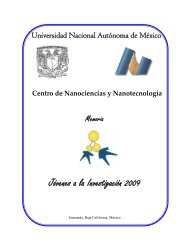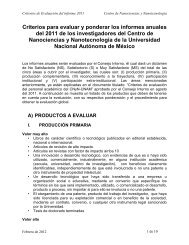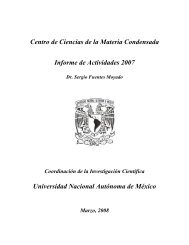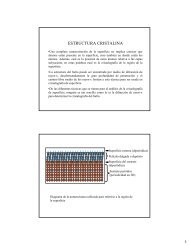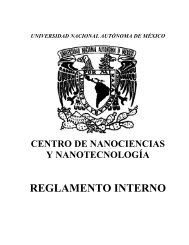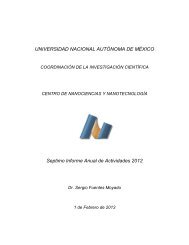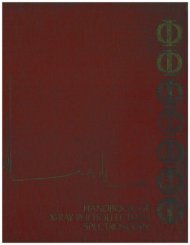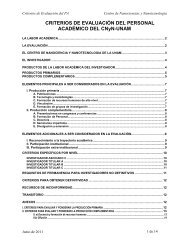Universidad Nacional Autónoma de México - CNyN
Universidad Nacional Autónoma de México - CNyN
Universidad Nacional Autónoma de México - CNyN
Create successful ePaper yourself
Turn your PDF publications into a flip-book with our unique Google optimized e-Paper software.
1st International Symposium on Nanoscience and Nanomaterials<br />
P-015<br />
CL STUDY OF HOLLOW ZnO:B MICRO-RODS GROWN BY THE HYDROTHERMAL METHOD<br />
R. Camacho 1,a and M Herrera 2,b<br />
1 Facultad <strong>de</strong> Ciencias, <strong>Universidad</strong> <strong>Nacional</strong> Autónoma <strong>de</strong> México, Coyoacán, Distrito Fe<strong>de</strong>ral 04510,<br />
México<br />
2 Centro <strong>de</strong> Nanociencias y Nanotecnología, <strong>Universidad</strong> <strong>Nacional</strong> Autónoma <strong>de</strong> México, Ensenada, Baja<br />
California 22800, México<br />
Keywords: ZnO:B, microrods, cathodoluminescence.<br />
a mrc@ciencias.unam.mx, b zaldivar@cnyn.unam.mx<br />
Hollow ZnO:B micro-rods were synthesized by a hydrothermal method at atmospheric pressure. A<br />
chemical <strong>de</strong>composition of zinc acetate in a controlled alkaline environment generated the growth of ZnO<br />
rods with a flower-like morfology. Boron impurities were incorporated in ZnO by the addition of orthoboric<br />
acid in the chemical synthesis, at several concentrations. SEM images revealed that Boron incorporation<br />
generated the formation of hollow ZnO microrods, with wall thickness of about 200 nm. A helical growth<br />
mechanism along the [0001] direction has been proposed to explain the formation of this morphology. CL<br />
measurements at room temperature show a homogeneous emission along the ZnO:B rods, composed by two<br />
bands centered at 2.12 and 2.5 eV. CL measurements at 100 K show only the formation of a strong yellow<br />
emission (2.12 eV). Electrical conductivity along single micro-rods was also studied, using a<br />
micromanipulator in the SEM. We discuss a possible <strong>de</strong>pen<strong>de</strong>nce between the electrical conductivity and<br />
boron concentration in ZnO micro-rods.<br />
P-016<br />
CuFe 2 O 4 NANOSTRUCTURED PARTICLES AS PHOTOCATALYST FOR H 2 GENERATION<br />
FROM WATER AND SUNLIGHT<br />
Ortega López Merce<strong>de</strong>s Yudith 1,a , Salinas Gutiérrez Jesús Manuel 1,b , López Ortiz Alejandro 1,c , Collins-<br />
Martínez Virginia 1,d<br />
1 Centro <strong>de</strong> Investigación en Materiales Avanzados S. C., Laboratorio <strong>Nacional</strong> <strong>de</strong> Nanotecnología, Depto. <strong>de</strong><br />
Materiales Nanoestructurados, Miguel <strong>de</strong> Cervantes 120, C. P. 31109, Chihuahua, Chih. México.<br />
a yudith.ortega@cimav.edu.mx, b jesus.salinas@cimav.edu.mx, c alejandro.lopez@cimav.edu.mx,<br />
d virginia.collins@cimav.edu.mx<br />
Keywords: Copper Ferrite (CuFe 2 O 4 ), Nanoparticles, Photocatalytic Activity, Water Splitting.<br />
The present research is aimed to reduce one of the main limitations of photocatalytic processes,<br />
which <strong>de</strong>als with higher efficient photocatalysts to be activated un<strong>de</strong>r the sunlight spectrum (energy band gap<br />
between 1.5 to 3eV). The objective of this paper was to study an alternate semiconductor to TiO 2 , which<br />
presents a lower band gap value than 3.0 eV. This study inclu<strong>de</strong>d; synthesis, characterization and<br />
photocatalytic evaluation of copper ferrite (CuFe 2 O 4 ) prepared through co-precipitation and thermal treatment<br />
for the generation of hydrogen un<strong>de</strong>r visible light. Characterization of the material was performed by XRD,<br />
BET, SEM, TEM and UV-Vis spectroscopy. Results indicate that the material presented only the CuFe 2 O 4<br />
crystal phase, with a BET surface area of 70 m 2 /g and particle sizes smaller than 10 nm. Photocatalytic<br />
evaluation un<strong>de</strong>r visible light irradiation followed by gas chromatography resulted in the hydrogen production<br />
32




